Q1 GDP was revised upward to 1.1%. Originally GDP was estimated to be 0.5%, then revised up to 0.8% and now reported to be 1.1%. While consumer spending was revised somewhat lower again, exports came to the rescue and bumped up Q1 GDP. Private investment contraction was less than originally estimated as well. Now GDP is still weak but not anything to be concerned about. Seems revisions always change the economic growth story and Q1 is no exception.
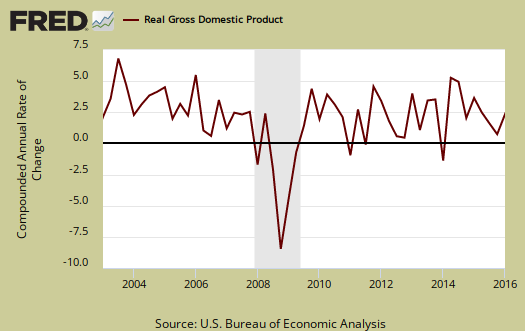
As a reminder, GDP is made up of: where Y=GDP, C=Consumption, I=Investment, G=Government Spending, (X-M)=Net Exports, X=Exports, M=Imports*. GDP in this overview, unless explicitly stated otherwise, refers to real GDP. Real GDP is in chained 2009 dollars.
The below table shows the Q1 GDP component contribution revisions and their percentage point difference. As one can see exports was the big change.
| Comparison of Q1 2016 2nd and third revision | |||
|---|---|---|---|
|
Component |
Q1 2016 2nd Estimate |
Q1 2016 3rd Estimate |
Spread |
| GDP | +0.82 | +1.08 | +0.26 |
| C | +1.29 | +1.02 | -0.27 |
| I | -0.45 | -0.29 | +0.16 |
| G | +0.20 | +0.23 | +0.03 |
| X | -0.25 | +0.04 | +0.29 |
| M | +0.03 | +0.08 | +0.05 |
The below table shows the GDP component comparison in percentage point spread from Q4 to 2016 Q1. With this latest revision the change is not so bad.
| Comparison of Q4 2015 and Q1 2016 GDP | |||
|---|---|---|---|
|
Component |
Q4 2015 GDP |
Q1 2016 GDP |
Spread |
| GDP | +1.38 | +1.08 | -0.30 |
| C | +1.66 | +1.02 | -0.64 |
| I | -0.16 | -0.29 | -0.13 |
| G | +0.02 | +0.23 | +0.21 |
| X | -0.25 | +0.04 | +0.29 |
| M | +0.11 | +0.08 | -0.03 |
Consumer spending, C was revised downward over a quarter of a percentage point. The downward revision was almost all services of various kinds. Below is a percentage change graph in real consumer spending going back to 2000.

Graphed below is PCE with the quarterly annualized percentage change breakdown of durable goods (red or bright red), nondurable goods (blue) versus services (maroon).
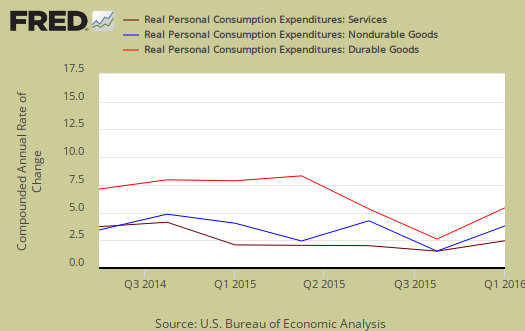
Imports and Exports, M & X really saved the day with a 0.33 percentage point upward swing from the 2nd revision. Goods exports was revised up by 0.30. Imports were revised downward and added an additional 0.05 percentage points to GDP.
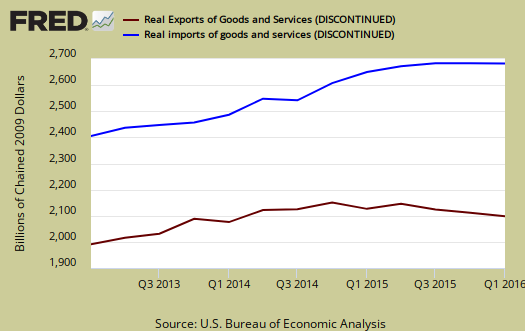
Government spending, G contributed 0.23 percentage points to Q1 GDP with Federal spending subtracting -0.11 percentage points from GDP while state and local governments added 0.34 percentage points, an upward 0.03 percentage point revision.

Investment, I is made up of fixed investment and changes to private inventories. The change in private inventories alone was a -0.23 percentage point contribution. Below are the change in real private inventories and the next graph is the change in that value from the previous quarter.
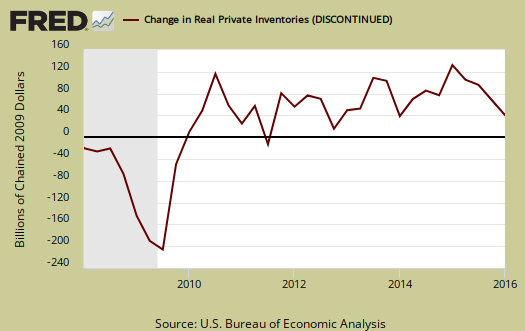
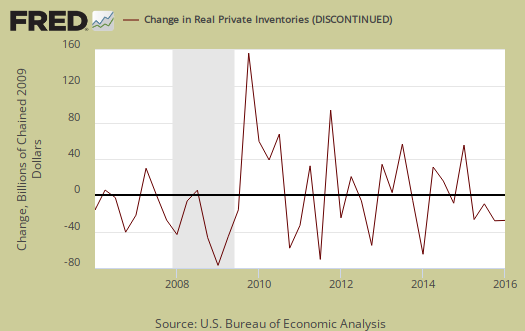
Fixed investment is residential and nonresidential was revised upward to be only a -0.06 percentage point GDP contribution. Nonresidential was much less of negative on GDP, revised upward to a -0.58 percentage point contribution from -0.81. Within nonresidential investment, equipment was still horrific subtracting over half a percentage point of GDP.
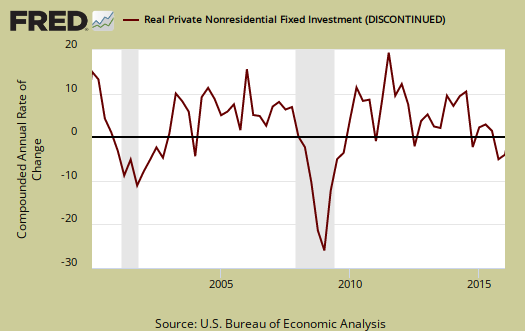
Residential fixed investment now added 0.52 percentage points to GDP. The below graph shows residential fixed investment.
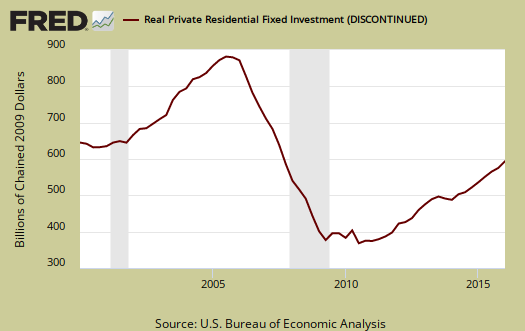
Nominal GDP: In current dollars, not adjusted for prices, of the U.S. output,was $18,230.1 billion, a 1.4% annualized increase for Q1 from Q4. In Q4, current dollar GDP increased 2.3%, showing Q1's growth was stunted when not adjusting for inflation.

Real final sales of domestic product is GDP - inventories change. This figures gives a feel for real demand in the economy. This is because while private inventories represent economic activity, the stuff is sitting on the shelf, it's not demanded or sold. Real final sales increased 1.3%.

Gross domestic purchases are what U.S. consumers bought no matter whether it was made in Ohio or China. It's defined as GDP plus imports and minus exports or using our above equation: where P = Real gross domestic purchases. Real gross domestic purchases increased 0.9% in Q1. Exports are subtracted off because they are not available for purchase by Americans, but imports are available for purchase in the U.S. When gross domestic purchases exceed GDP, that's actually bad news, it means America is buying imports instead of goods made domestically.
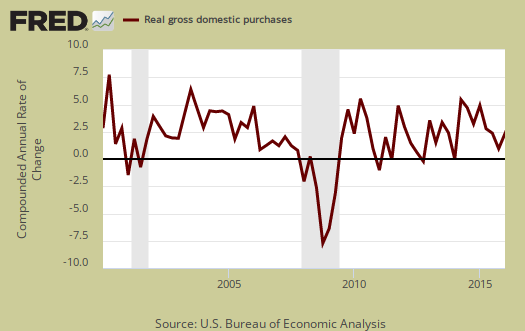
The price index for gross domestic purchases increased 0.2% for Q1, revised down from 0.3%. Without food and energy considered, the core price index increased 1.4%. In Q4 the price index was 0.4% for both the overall and without food and energy considered, 1.0%. That's quite below the Federal Reserve's target inflation rate, even when taking gasoline prices out of the equation and rising rents across the country. Below is the price index for gross domestic purchases.
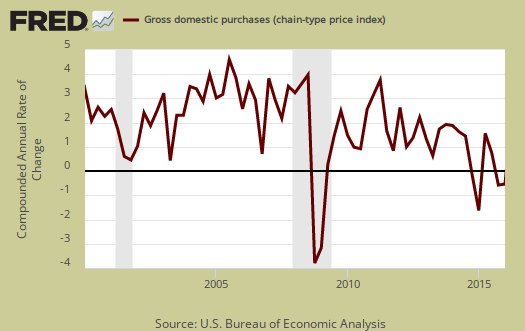
GNP - Gross National Product: Real gross national product, GNP, is the goods and services produced by the labor and property supplied by U.S. residents.
GNP = GDP + (Income receipts from the rest of the world) - (Income payments to the rest of the world)
Real GNP increased just 0.2% for Q`. In Q4 GNP increased 1.1%. GNP includes, whereas GDP excludes, net income from the rest of the world. GNP increases beyond GDP if Americans made out like bandits from foreign investments more than foreigners cashed in on investments within the U.S. borders.
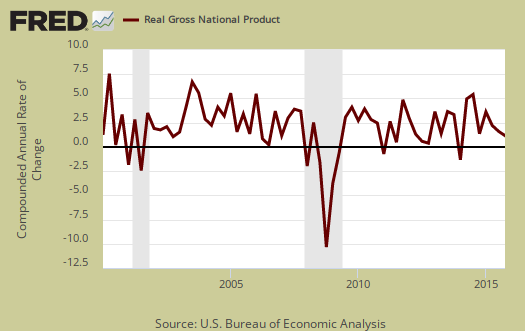
GDI - Gross Domestic Income: Gross Domestic Income is all income from within the borders of a nation and should normally equal GDP. GDI is wages, profits & taxes minus subsidies. Real GDI was 2.9% in Q1. Q4 GDI was a 1.9% increase. The BEA says GDI measures the economic output as the costs incurred as well as incomes earned in the production of GDP. The BEA also states GDI can have statistical discrepancy over short time periods, yet this is a fairly far spread by GDP and might show things are weaker than GDP indicates.
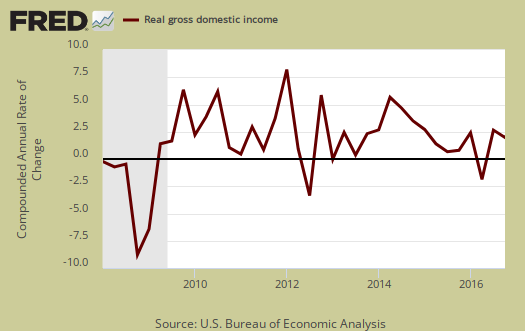
Below are the percentage changes of the Q1 2016 GDP components, from Q4. There is a difference between percentage change and percentage point change. Point change adds up to the total GDP percentage change and is reported above. The below is the individual quarterly percentage change, against themselves, of each component which makes up overall GDP. Additionally these changes are seasonally adjusted and reported by the BEA in annualized format.
|
Q1 2016 GDP Component Percentage Change (annualized) |
|||
|---|---|---|---|
| Component | Percentage Change from 2015 Q4 | ||
| GDP | +1.1% | ||
| C | +1.5% | ||
| I | -1.8% | ||
| G | +1.3% | ||
| X | +0.3% | ||
| M | -0.5% | ||
This GDP report is seemingly so much better news after the original paltry 0.5% gain. The best thing is the export revision while investment still paints a fairly bleak economic picture.
Other overviews on gross domestic product can be found here. The BEA GDP site is here.

current dollar GDP
interesting that growth in current dollar GDP at 1.4% was unrevised from the second estimate...don't recall that i've ever seen such a large revision in the GDP deflator this late in the game..
rjs
1st quarter GDP will likely be revised higher
today's construction spending report showed the annual rate of construction spending for March was revised from $1,155.1 billion to $1,176.4 billion, and the annual rate of February construction spending was revised up from $1,137.9 billion to a $1,157,7 billion rate...combined, those revisions are enough to add 0.25 percentage points to 1st quarter GDP....that will likely show up in the annual GDP revisions to be released early August
rjs
revisions
Sure seems like the revisions are way off of the mark. I know they publish margins of error and percentages of corrections but these do seem huge.
annual revisions
i just realized that construction spending went through an annual revision (i thought it had one a few months ago) so i'll have to recompute the quarterly change against the revised 4th quarter data, but it still looks huge..
rjs